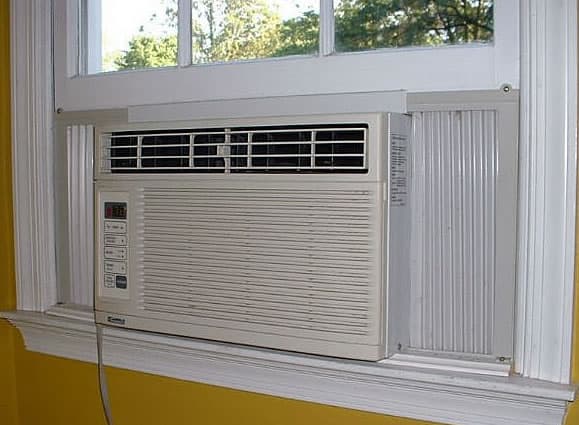Properly sealing your window air conditioner is essential because it keeps the cool air from escaping your room.
However, the process has challenges that could render the application ineffective if incorrectly sealed. So how do you seal a window air conditioner?
The basic procedure appropriately seals the window’s inside and outside edges. You’ll need adhesive foam for a larger gap, while rope caulk is needed for a narrow gap.
However, it’s easier than done, and if you want to know more about how you can effectively seal them, let’s continue with today’s article, and I will give you the solution you need.
What Do You Put Around a Window Air Conditioner?
You can do several things to shut the gaps and prevent the elements from entering your home. First and foremost, you must understand that there are two types of gaps here—narrow and larger.
For narrow gaps, the recommended application is a rope caulk.
It is a clay-like material that acts as an adhesive similar to the effects of epoxy clay used in roofs.
On the other hand, you will need adhesive-backed foam weather stripping to fill larger breaches. They are typically made of vinyl that has strong adhesive properties.
These substances are highly reliable once applied correctly. They do not deteriorate, peel, or fall off easily, even when exposed to direct sunlight, dust particles, and rainwater.
Side curtains or frames around the air conditioner are also advisable to improve room insulation. It also helps prevent bugs from entering the premises if the seal has been breached.
Do You Need To Seal Window Air Conditioner?
Air conditioners are a necessity in every household, especially during summer days. They maintain the cool temperature of your room and make it as comfortable as possible.
Applying sealants is a norm to fill in the gaps during installation. But sometimes, the sealing isn’t perfect, leading to minor displeasure in your home.
Proper sealing of gaps between the window and air conditioner edges is crucial. If you fail to attend to them, it could lead to leaks and the inability of the fixture to maintain room temperature.
Also, even the smallest gaps, as benign as they seem, could invite dust particles and insects like mosquitoes and house flies to enter your home.
The process has to be performed on both the inside and outside. And the apparent reason for this is to have a second layer of protection if one seal wears off.
How to Seal Window Air Conditioners?
The sealing process can be done by sealing gaps larger than 1/8 inch and narrow or hard-to-reach gaps. And the type of procedure you will use will depend on the problem—is it a small or large breach?
The following section contains the steps to seal the window air conditioner properly.
Sealing Gaps Larger than 1/8 Inch
A gap is considered significant if it measures more than 1/8 inch. And they are relatively easier to manage because all you have to do is measure the hole and place the adhesive accordingly.
But to give you a better overview of the process, refer to the following simple instructions:
- Firstly, you must clean the gaps between the air conditioner and the wall. Next, thoroughly wipe off the grease, dust, dirt, and gunk accumulated from the previous adhesive.
- And then, you have to measure the length of the gap from point to point. Then, cut a piece of the adhesive foam according to your measurement.
- Now, peel the paper portion of the cut adhesive foam and place the sticky side on the window frame.
- Press the adhesive to seal the gap properly
Ensure you have cleaned the surfaces well before applying the adhesive foam. The adhesive will easily peel or fall off if the surface is dirty and exposed to direct sunlight.
Sealing Narrow or Hard-To-Reach Gaps
On the other hand, Narrow gaps are a little challenging to remedy due to the apparent size of the breach. However, it is repairable, and you only have to be patient.
Before you begin filling in the gaps, you have to prepare the following materials:
- Adhesive-Backed Foam Weather Stripping
- Tape Measure
- Rope Caulk
- Cloth
- Utility Knife
Now, the actual sealing process of the gaps is as follows:
- Similar to the more significant gaps, you still have to measure them to get the right amount of caulk. And then, tear the rope caulk according to the measurement
- Place the caulk on the gap and press it. If the gap is deep, you may need another piece of caulk and press them with a slight force to fill the gap
- Lastly, you can scrape off and wipe away excess caulk. Smoothen the surface with a dry cloth
Rope caulk has a similar appearance and texture to modeling clay or silly putty. As strong as they may be, you can easily remove and store them during winter.
However, a rope caulk may be ineffective for more than one-inch gaps. In this effect, you may have to turn to fiberglass insulation to fill the gaps tightly.

Another helpful tip is you may want to look for gaps above the air conditioner. Since the appliances are resting on the window sill, we may see the gaps commonly occur in its upper area.
Lastly, you can reuse rope caulk if it’s still clean after you have removed them. Peel them off, put them in a sealed plastic bag, and store them for later use.







